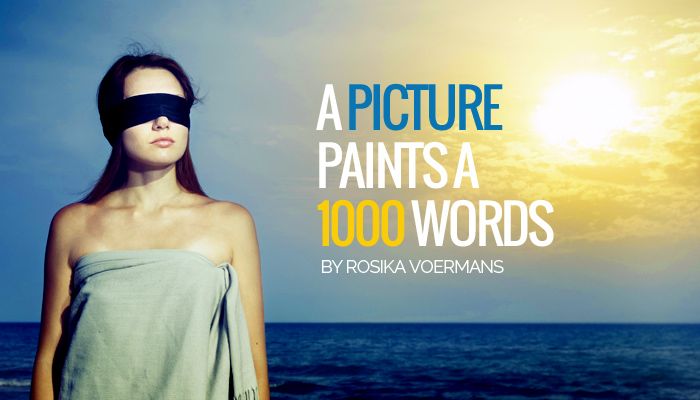
You’ve heard the saying: ‘A picture paints a thousand words’. You probably also know that on meeting new people, it takes about 50 milliseconds for someone to form an impression of you. People spend billions each year on the perfect-view vacation. Couples have had serious feuds over the right colour for their interior while some car manufacturers go out of their way to paint their cars a colour we’ve never seen before, striving for the perfect visual of design and hue.
In fact, as far as we can remember throughout the history of mankind, we have always sought beauty in one way or another. It’s about that moment when the pupil meets perfection and makes harmonic sense to the viewer. By now one thing is for sure: eye candy matters.
But visuals and images are not only for viewing pleasure, they are also hugely effective in aiding the human brain to process and understand concepts and ideas faster.
Yet few people truly understand the impact that images can have on your advertising, which would include your website. Many clients believe that by just launching a new website, cash would magically start rolling in. The reality? It doesn’t. The buy-in persuasion of your website has an intricate checklist of requirements. One of those requirements includes images and the important part they play.
When we are appointed to develop a new website, one of the most important factors we discuss with our clients is the use of quality imaging. Unfortunately, most clients believe that smartphone snapshots are more than sufficient to sell their product and service. The question to ask is whether you believe you will ‘out-sell’ your competition, who went ahead spending money on a proper photoshoot? Unless you have a product that is exceedingly unique, we’re willing to bet you won’t.
But why is visual content so important?
- It is estimated that approximately 85% of all communication will be visual content by 2018.
- Social media posts that include images produce 650% higher engagement than regular text posts.
- Social media platform Pinterest has had a 111% in active users during 2014 while Instagram enjoyed a 64% growth factor during the same year. Both of these are driven by visual content.
- Facebook posts with brands including images earned 87% of all activity.
- 93% of all human communication is practically non-verbal.
Do you see where this is going? We’re going to give you a head’s up: Change your game and gear up.
If you’ve decided to take your advertising visuals to the next level, congratulations! This important decision means your online presence will survive past 2018. So what are the basic rules of good imaging?
SPEND MONEY
Whether you’re in the product or travel/destination business, it’s almost compulsory to set aside a serious budget for photography. With most users more likely to purchase by means of the ability to view good quality images and/or video, having text-only content of products on a website, no longer applies – even if it has detailed descriptions.
Think of it this way: If you’ve gotten married in the past 5 years, you probably spent approximately R20-R30k on your wedding photos. Those photos will serve as a memoir of a beautiful day for life. Therefore, wouldn’t it make sense to spend the same or more on the business that will sustain you for life?
QUALITY
If you've decided that you’re not going to help some photographer buy his groceries this month and insist that you smartphone can do it all, then you’re next commandment is ‘image quality’.
High resolution is key, in particular with product images. Not only does your website look more professional and crisp, but it serves to inform your visitor of the details. Statistics show that detailed images can draw the attention of up to 67% of your targeted audiences. For instance, if someone is buying a shoe on your fashion site, it’s important to be able to zoom into the photo in order to view the stitching or inner sole quality. If we placed a nice-looking shoe 10 meters away from you and asked you whether you’d buy it without getting closer, would you buy it?
Other factors like lighting also comes into play. Product photos should be well-lit with proper contrasts. Hard shadows and built-in camera flash lighting immediately constitutes a photo with poor quality. Using natural light for your photos should only be reserved for proper photographic gear and a good knowledge of art of photography.
BE REAL
Advertise your product as it is, and only that. If you’re in the business of selling body products, don’t photograph your body lotion with an orchid, zen-stacked stones and a soap next to it. We’re not saying that you can’t create a theme with a nice background, but on website pages where you’re featuring the product itself in thumbnail view, keep it clean and show the product as it is. Most products are best shot on isolate / white backgrounds as this is least interfering and leaves the visitor with the ability to focus on the sale. Themed images can be used on your home page, where most websites feature a rotating banner to display various product categories.
Most importantly, be sure that the way a product is presented, is exactly what your customer will receive. Misrepresentation of a product leaves a nasty mark on your brand and in some countries, the consumer takes misrepresentation straight to the courtroom. In example, if a photo of a burger on your menu looks juicy with nice fresh lettuce, melting cheese and a crisp sesame bun, don’t serve your customer a pale patty on a bashed-in soft bun and wilting lettuce. Make sure that your photos are realistic and in tune with your customer’s expectations.
ALTERNATIVES
Service-based businesses have a harder time pinning down ‘what they do’ on a photo. In these cases, we recommend stock images. Simply put, these are images you license from the owner in order to use on your website. And yes, you pay for these.
“But I can download great images from Google” we hear you say. Downloading an image from Google, doesn’t mean you have the right to use it – especially for commercial use. Copyright infringement can cause very serious legal action to be taken against you and images don’t always have to say “Copyright protected”.
If you’re using stock imaging, make a point of being different. Nothing creates a yawn as fast as an image of people in a boardroom or JASF (Just Another Smiley Face). Set your brand apart from the competitor and select images with impact, drama, alternative concepts, mood, ambiguity or even humour.
Take care of images that have such hidden meanings that most don’t understand the first basic message. Test an image with a few people to see whether you’re on the right track or whether ‘one flew over the cuckoos nest’.
BE THE CONSUMER
When in doubt, compare your photos with the ones on best-selling websites and then ask a question as if you were the consumer: “Would I buy this product online?” If you’re answering ‘yes’, then you should be able to see an increase in time spent via your web analytics, and ultimately your sales.
BE TARGET SPECIFIC
Understand whom you are aiming your product at. Older generations would typically resonate more with classic concepts while younger generations would focus more on vibrant and edgy photography. The same logic applies to many other parameters – whether dealing with males or females, children, investment, entertainment, life or death. Therefore consider how your product ties in with your target market and then focus on how your product or service would increase the consumer’s experience positively.
At Aftershock, we understand the importance of visual impact. With 70% of all sensory receptors that humans have being concentrated inside the eye and up to 50% of that information being processed, it’s not difficult to understand that quality visual content is here to stay. Quality text content with the right image ensures that your target audience becomes captivated with imagination and attention.

